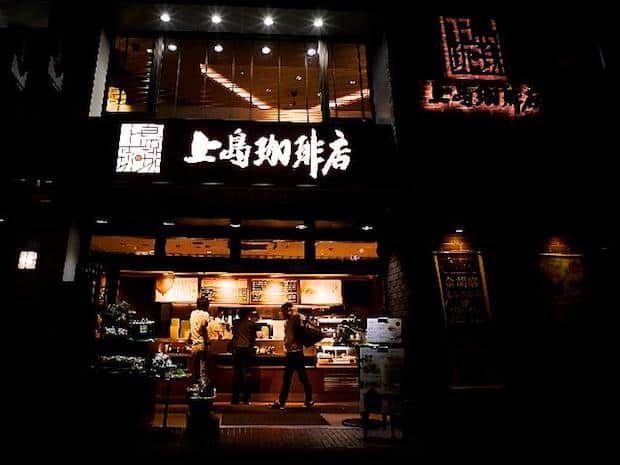Last Updated on December 8, 2023
Japan is synonymous with efficiency, discipline, and grace, and their coffee culture is an extension of that.
Convenience is essential for a fast-paced, hard-working society, and there are endless coffee options on every corner. You can find anything from canned coffee in a vending machine to a $20 beverage hand-crafted with patience, skill, and precision. There’s a rich history of experimentation and invention, born of a desire to brew the perfect cup of coffee. And Japan is one of the largest importers of coffee in the world.
Japan has enthusiastically embraced third-wave coffee culture, which is a natural full circle, returning to the passion and precision long held within the culture.
View this post on Instagram
History of Japanese coffee culture
For several centuries Japan was a tea-drinking culture, with the traditional tea ceremony holding great spiritual and cultural significance. Coffee was first introduced by the Dutch, Japan’s only Western trading partner during its isolationist period (mid-1600s to mid-1800s), but at first reception the locals rejected the “burnt”-tasting coffee, and the Dutch traders of Nagasaki were the only ones who really consumed it. It wasn’t until trade opened in the mid 1800s that coffee beans began trickling more steadily into the country.
In 1888, the first notable Japanese coffee shop was opened by Eikei Tei in Tokyo’s Ueno district. Tei was enchanted by the cultural vibrancy of cafes he frequented in France while studying abroad, and he attempted to emulate their style in his home country. Tei’s shop lasted only a few years, but it inspired several other cafes around Tokyo—predominantly in the chic and culturally relevant Ginza district.
The popularity of coffee was on the rise at the turn of the century, but when Japan banned all imports of coffee after the Second World War, the trend slumped. It wasn’t until the the early 1960s that coffee began freely flowing into the country again. The import of affordable and easy-to-brew instant coffee in the ’60s saw coffee seep into households around the country, and the economic boom of the ’60s and ’70s powered a steady increase in demand for the elevating beverage.
Hiromichi Toriba seized the moment. By anticipating the needs of a growing workforce, he built Japan’s most popular and lasting chain of coffee shops. He imagined this burgeoning workforce would require convenient caffeination and breakfast items, as a fast-paced urban lifestyle was rapidly developing in every big city. He bet on the right horse, and his chain of Doutor coffee shops quickly dominated the marketplace, offering affordable, simple, coffee to go.
When Starbucks entered the scene in the 1990s, with its “third place” ideology—a place to relax that is neither home nor work—more sit-down cafes started popping up. Doutor had to refine its model in order to compete with the influx of international chains.
A place to escape the hustle and bustle of daily life was not new to Japanese culture. Kissatens— traditional tea houses that had long been places of refuge and refinement—began selling coffee in the 1960s and initially were one of the few places to enjoy coffee outside the home or a hotel. Kissatens have always been spaces of respite, offering a place for customers to unwind from the increasingly hectic urban lifestyle.
As popularity of coffee rose, kissatens came to embody an intentional approach to the process itself, with a focus on high-quality, hand-crafted beverages. Coffee was brewed slowly, with water hand-dripped in a pour-over style, resulting in a strong, complex, and nuanced cup of coffee. Kissaten owners were constantly experimenting and tweaking their brewing methods in an attempt to master the process and extract the very best from their beans.
View this post on Instagram
It’s not surprising that several of the most iconic equipment brands, particularly for siphon and pour-over, are Japanese companies.
Current Japanese coffee culture
Doutor remains popular for a basic coffee and no-fuss meal, and international coffee chains like Starbucks are found around the country, particularly throughout Tokyo. As cafe culture rose around the world in the 1990s and 2000s, cafes became meeting places and social hubs. Lingering over your beverage while catching up with friends became more common. Some of the largest and busiest Starbucks locations in the world are in Tokyo, and although many people still prefer their coffee on the fly, most cafes have beautiful seating areas and offer simple meals.
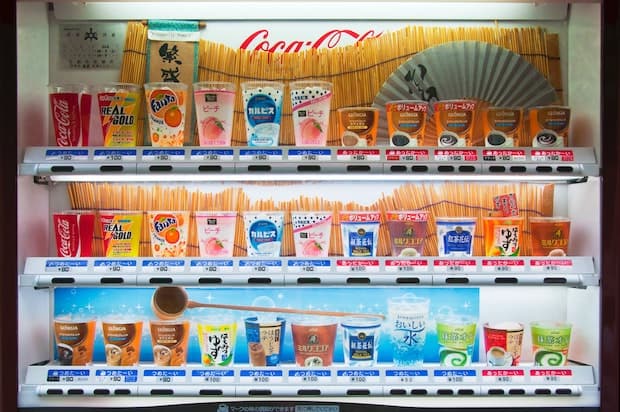
For those who value convenience over anything else, coffee—both hot and cold—can be purchased from vending machines that speckle the streets. “Fresh brewed” coffee from convenience stores such as 7-Eleven has been on the rise since 2013, with many stores adding small seating areas to encourage customers to stick around. Although brewed to order by an automated machine, and arguably better than coffee that’s been sitting in a canister for hours, convenience store coffee is of relatively low quality, but offers a cheaper and quicker option than cafes.
Although convenience is king, Japan has embraced—if not inspired—the current third wave of coffee culture. James Freeman of Oakland-based Blue Bottle Coffee, a pioneer of the current artisanal cafe trend, has always felt a kinship with Japanese culture. He visited his first kissaten in 2007, and recognized his then fledgling California-based specialty coffee business was moving in the right direction, sharing the meticulous attention to detail and pride in craft he observed in the modern kissatens of Tokyo. It seemed like a natural full circle when Blue Bottle Coffee Japan opened their first Tokyo location in 2015, and alongside other artisanal imports such as Fuglen—with locations in Oslo and Tokyo—and New Zealand’s AllPress Espresso Japan, helped solidify the embrace of Japan’s third wave cafes.
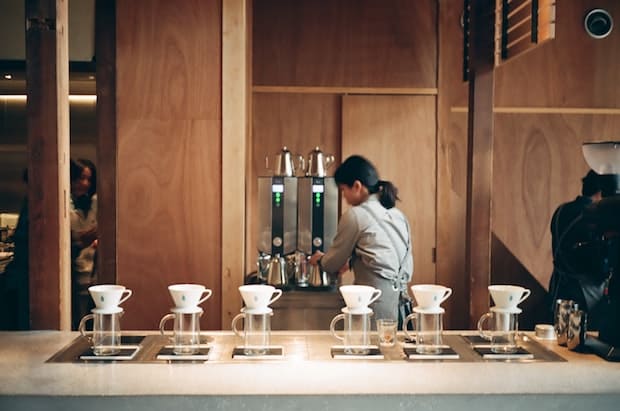
Local independent shops were already springing up around Tokyo, and although they are markedly more modern in decor, the influence of traditional kissatens can’t be denied. These specialty coffee shops, like Tokyo’s Arise Coffee Roasters, embody the traditional values of quality and craftsmanship that kissaten owners have been practicing for decades.
A pour-over is still the most popular form of coffee and many kissatens serve only hand-drip coffee, viewing espresso as a departure from the highly regarded art of hand crafting beverages.
Modern coffee shops have adopted the espresso machine and milk-based drinks with fervor, and are continually creating unique and exciting new beverages. Modern shops also tend to be busy and bustling, and many older Japanese residents still prefer the quiet kissatens.
Modern kissatens are steeped in nostalgia. Their dark and elaborate decor offers a touch of luxury, and they tend to be quiet and peaceful, which is a welcome respite from the sensory overload of cities like Tokyo. They also happen to be one of the few places that still have indoor smoking sections. They’re a throwback to the bohemian culture of the 1960s and 70’s, and they tend to be uniquely kitschy, often emulating the personal style and interests of the owners. The younger generations visit kissatens for the “hip” factor, and to soak up the romanticized bohemian past, but also to revel in the serenity that more contemporary cafes lack.
Cultural contributions
The most evident Japanese contribution to the current coffee landscape is the equipment of brands like Kalita and Hario, both highly regarded and widely used around the world. Japanese coffee equipment, mostly geared toward hand-drip methods, is known for quality and reliability without being too expensive.
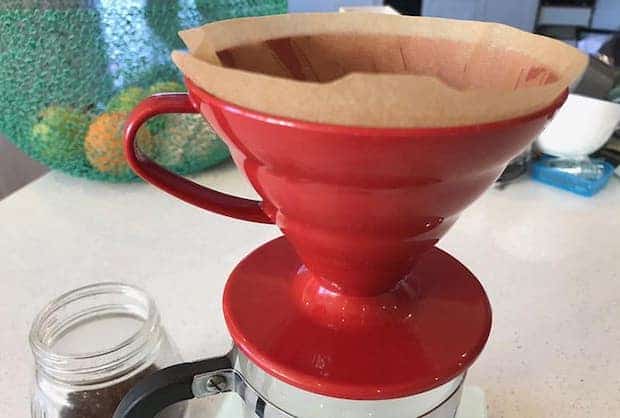
We mustn’t discount the contribution of kissatens to current third wave coffee culture. Freeman himself was admittedly inspired by the thoughtful and intentional approach the Japanese bring to coffee preparation, and their culture at large. Third wave coffee culture in Japan seems much more a return to the traditional rather than something new, and likely why this product- and process-focused approach was easily adopted and refined throughout the country.
Japan may not have led the international third wave, but likely inspired it by more circuitous and pervasive means.
Etiquette
Japan is an amazing place to explore coffee. Not only will your drink be of the utmost quality, but the service is unparalleled. If you want something quick, cheap and simple, you have myriad options anytime of day or night. There are no particular customs as to what you should drink or when, and there is always something available—it just might be in a can.
If you you do have the time and a few extra yen to invest in the fastidious Japanese process of brewing and crafting beverages of the highest order, you should absolutely indulge. If you’re looking to have a truly elevated experience you may have to shell out somewhere between $15-$20. Depending on your chosen brew method, it may take upwards of 10 minutes to prepare.
Patience and kindness are both appreciated and reciprocated in Japanese cafes, and the country in general (some would say the world). Japanese service is attentive, and extremely knowledgable, and they’re happy to guide you without judgment or expectation that you’re already a coffee connoisseur. Not only will you be served with attention and grace, but the presentation of your beverage will undoubtably be Instagram-worthy. Many cafes use beautiful ornate cups, and you’ll often receive your coffee on a lovely tray with all necessary accessories and fixings. The process is immensely thoughtful and intentional. Enjoying it should be the same.
What to order
You absolutely must have a pour-over coffee, whether from a contemporary cafe or a kissaten. Both will feature thoughtfully sourced and roasted beans, and will be prepared with skill that has been perfected over decades of creative experimentation. The pour-over process allows the subtle qualities of the coffee to shine through, honouring both place and process. I recommend drinking this intoxicating brew black, to truly experience the bouquet of aromas and complexity of flavour.
Japan probably has the widest and most eclectic variety of speciality coffees in the world, so you’ll never be short on fun options to try. If you love a well made latte or cappuccino, you’ll find all the classics made with care and precision. There is also iced coffee in a multitude of preparations, as well as a multitude of creative tea-based drinks.
Final thoughts
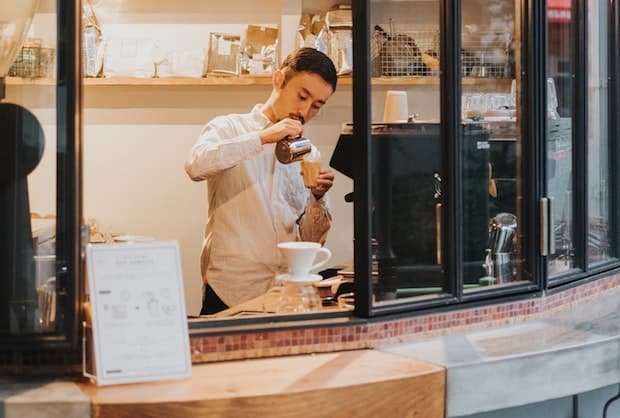
Japanese coffee culture is an inspiring mix of tradition and innovation, delivered with their quintessential refinement and style. No matter which style of coffee you enjoy, you’ll be able to find them in a Japanese cafe. A trip to Japan would not be complete without a visit to a modern kissaten to enjoy a hand-dripped coffee, but you’ll also find an abundance of contemporary cafes full of personality and charm. You’ll be greeted with warmth and kindness wherever you go, and you’ll likely be guided through an experience that will awaken both your body and your soul.

